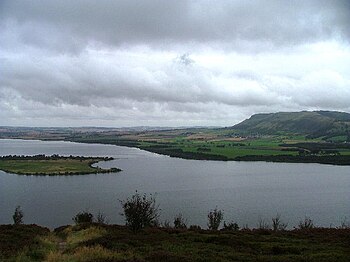Loch Leven, Kinross-shire: Difference between revisions
Created page with 'right|250px|thumb|Loch Leven northward from Vane Farm '''Loch Leven''' is a fresh water loch within Kinross-shire. The loch is roughly trian…' |
No edit summary |
||
| (3 intermediate revisions by 2 users not shown) | |||
| Line 1: | Line 1: | ||
[[File:Loch Leven Kinross.jpg|right| | [[File:Loch Leven Kinross.jpg|right|350px|thumb|Loch Leven northward from Vane Farm]] | ||
'''Loch Leven''' is a fresh water loch within [[Kinross-shire]]. | '''Loch Leven''' is a fresh water loch within [[Kinross-shire]]. | ||
The loch is roughly triangular, about | The loch is roughly triangular, about four miles at its longest. The town of [[Kinross]] stands at its western end and its parish extends around the shoreline, incorporating it and the western islands. | ||
[[Loch Leven Castle]] lies on | [[Loch Leven Castle]] lies on Castle Island a short way offshore and can be reached by ferry, operated from Kinross by [[Historic Scotland]] during the summer months. The castle was the prison of [[Mary, Queen of Scots]] in 1567, though modern day visitors can expect to be permitted to leave. | ||
Loch Leven has shrunk somewhat since the [[River Leven, Fife|River Leven]] was canalised in the early 19th century. The fall in water level exposed several small islands, and greatly increased the size of the existing ones. Several artefacts were found during the drainage, including a sceptre, "apparently of cane, hilted with ivory, and mounted with silver, upon which ... were the letters of the words, "Mary, Queen of Scots," found near the ''Mary Knowe'', where she is supposed to have landed after her escape from the castle.<ref>{{cite news|url=http://www.londonancestor.com/bells/1827-relics.htm|title=Ancient Relics|date=April 3, 1831|publisher=Bell's Weekly Messenger|accessdate=2009-07-10}}</ref> | Loch Leven has shrunk somewhat since the [[River Leven, Fife|River Leven]] was canalised in the early 19th century. The fall in water level exposed several small islands, and greatly increased the size of the existing ones. Several artefacts were found during the drainage, including a sceptre, "apparently of cane, hilted with ivory, and mounted with silver, upon which ... were the letters of the words, "Mary, Queen of Scots," found near the ''Mary Knowe'', where she is supposed to have landed after her escape from the castle.<ref>{{cite news|url=http://www.londonancestor.com/bells/1827-relics.htm|title=Ancient Relics|date=April 3, 1831|publisher=Bell's Weekly Messenger|accessdate=2009-07-10}}</ref> | ||
St Serf's Inch is the largest of Loch Leven's seven islands and | St Serf's Inch is the largest of Loch Leven's seven islands and uniquely forms part of the parish of [[Portmoak]]. It was the home of a Culdee and then an Augustinian monastic community, St Serf's Inch Priory. There was a monastic community on the island which was old in the 12th century. The monastery produced a series of Gaelic language charters from the 11th and 12th centuries which were translated into Latin in the late 12th century. | ||
Loch Leven is a National Nature Reserve, as well as a Site of Special Scientific Interest and a Special Protection Area. | Loch Leven is a National Nature Reserve, as well as a Site of Special Scientific Interest and a Special Protection Area. | ||
| Line 20: | Line 20: | ||
==References== | ==References== | ||
{{Reflist}} | {{Reflist}} | ||
[[Category:Lochs of Kinross-shire]] | |||
Latest revision as of 14:50, 19 August 2015

Loch Leven is a fresh water loch within Kinross-shire.
The loch is roughly triangular, about four miles at its longest. The town of Kinross stands at its western end and its parish extends around the shoreline, incorporating it and the western islands.
Loch Leven Castle lies on Castle Island a short way offshore and can be reached by ferry, operated from Kinross by Historic Scotland during the summer months. The castle was the prison of Mary, Queen of Scots in 1567, though modern day visitors can expect to be permitted to leave.
Loch Leven has shrunk somewhat since the River Leven was canalised in the early 19th century. The fall in water level exposed several small islands, and greatly increased the size of the existing ones. Several artefacts were found during the drainage, including a sceptre, "apparently of cane, hilted with ivory, and mounted with silver, upon which ... were the letters of the words, "Mary, Queen of Scots," found near the Mary Knowe, where she is supposed to have landed after her escape from the castle.[1]
St Serf's Inch is the largest of Loch Leven's seven islands and uniquely forms part of the parish of Portmoak. It was the home of a Culdee and then an Augustinian monastic community, St Serf's Inch Priory. There was a monastic community on the island which was old in the 12th century. The monastery produced a series of Gaelic language charters from the 11th and 12th centuries which were translated into Latin in the late 12th century.
Loch Leven is a National Nature Reserve, as well as a Site of Special Scientific Interest and a Special Protection Area.
-
View east across Loch Leven from Kinross
-
Satellite photograph of Loch Leven and the surrounding area
References
- ↑ "Ancient Relics". Bell's Weekly Messenger. April 3, 1831. http://www.londonancestor.com/bells/1827-relics.htm. Retrieved 2009-07-10.

